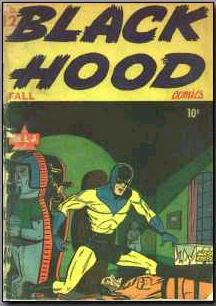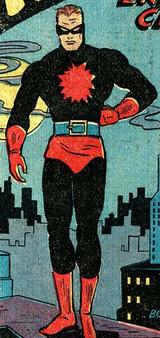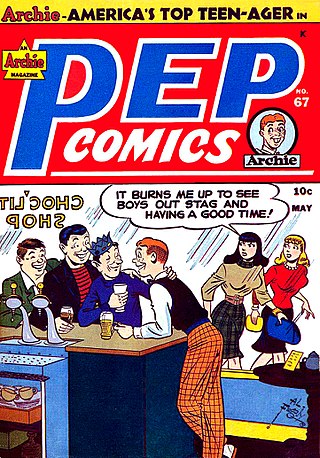Related Research Articles

A comic strip is a sequence of cartoons, arranged in interrelated panels to display brief humor or form a narrative, often serialized, with text in balloons and captions. Traditionally, throughout the 20th and into the 21st century, these have been published in newspapers and magazines, with daily horizontal strips printed in black-and-white in newspapers, while Sunday papers offered longer sequences in special color comics sections. With the advent of the internet, online comic strips began to appear as webcomics.
A daily strip is a newspaper comic strip format, appearing on weekdays, Monday through Saturday, as contrasted with a Sunday strip, which typically only appears on Sundays. They typically are smaller, 3-4 grids compared to the full page Sunday strip and are black and white.

The Sunday comics or Sunday strip is the comic strip section carried in most western newspapers. Compared to weekday comics, Sunday comics tend to be full pages and are in color. Many newspaper readers called this section the Sunday funnies, the funny papers or simply the funnies.

James Cecil Hatlo, better known as Jimmy Hatlo, was an American cartoonist who in 1929 created the long-running comic strip and gag panel They'll Do It Every Time, which he wrote and drew until his death in 1963. Hatlo's other strip, Little Iodine, was adapted into a feature-length movie in 1946.

Harry Conway "Bud" Fisher was an American cartoonist who created Mutt and Jeff, the first successful daily comic strip in the United States.

Pep Comics is the name of an American comic book anthology series published by the Archie Comics predecessor MLJ Magazines Inc. during the 1930s and 1940s period known as the Golden Age of Comic Books. The title continued under the Archie Comics imprint for a total of 411 issues until March 1987.

Black Hood Comics was the name of an American anthology comic book series published by MLJ Magazines Inc., more commonly known as MLJ Comics, for eleven issues between Winter 1943 and Summer 1946. The series featured MLJs costumed hero Black Hood, and "Boy Buddies", featuring Shield's partner 'Dusty the Boy Detective' and Wizard's side-kick 'Roy the Superboy', together with humor strips.

Blue Ribbon Comics is the name of two American comic book anthology series, the first published by the Archie Comics predecessor MLJ Magazines Inc., commonly known as MLJ Comics, from 1939 to 1942, during the Golden Age of Comic Books. The revival was the second comic published in the 1980s by Archie Comics under the Red Circle and Archie Adventure Series banners.

Firefly is a fictional comic book character created by Harry Shorten and Bob Wood for MLJ Comics in 1940. He first appeared in Top-Notch Comics #8. Artist Warren King and writer Joe Blair loaned their talents to many of the Firefly's installments.
Harry Frank Sahle was an American comic book artist who drew for such publishers as Archie Comics—helping create the defined look of Archie Comics' breakout character, Archie Andrews—Quality Comics and the Marvel Comics precursor company Timely Comics during the 1930s-1940s period historians and fans call the Golden Age of Comic Books.

Jackpot Comics was the name of an American anthology comic book magazine series published by MLJ Magazines Inc., more commonly known as MLJ Comics, for nine issues between Spring 1941 and Spring 1943. It featured new stories of a number of characters previously seen in other MLJ publications.
Frank M. Borth III was an American comic book artist.

Top-Notch Comics is an American comic book anthology series that was published by MLJ Magazines Inc., more commonly known as MLJ Comics, during the 1930s and 1940s period known as the Golden Age of Comic Books. From issue #28 it was re-titled Top-Notch Laugh Comics.

Shield–Wizard Comics was the name of an American comic book series published by MLJ Magazines Inc., more commonly known as MLJ Comics, for thirteen issues between Summer 1940 and Winter 1944.

Hangman Comics was the name of an American anthology comic book series published by MLJ Magazines Inc., more commonly known as MLJ Comics, for seven issues between Spring 1942 and Fall 1943. It featured MLJs costumed vigilante The Hangman, and "Boy Buddies", featuring Shield's partner 'Dusty the Boy Detective' and Wizard's side-kick 'Roy the Superboy', throughout the series.

McClure Newspaper Syndicate, the first American newspaper syndicate, introduced many American and British writers to the masses. Launched in 1884 by publisher Samuel S. McClure, it was the first successful company of its kind. It turned the marketing of comic strips, columns, book serials and other editorial matter into a large industry, and a century later, 300 syndicates were distributing 10,000 features with combined sales of $100 million a year.

Al Fagaly was a Golden Age American cartoonist and creator of Archie Comics' Super Duck and the syndicated gag cartoon There Oughta Be a Law!.

Louis Horace Silberkleit was an American publisher of magazines, books, and comic books; together with Maurice Coyne and John L. Goldwater, he co-founded MLJ Magazines, and served as its publisher for many years.
Harry Shorten (1914–1991) was an American writer, editor, and book publisher best known for the syndicated gag cartoon There Oughta Be a Law!, as well as his work with Archie Comics, and his long association with Archie's publishers Louis Silberkleit and John L. Goldwater. From the late 1950s until his 1982 retirement, Shorten was a book publisher, overseeing such companies as Leisure Books, Midwood Books, Midwood-Tower Publications, Belmont Tower, and Roband Publications.
Tower Publications was an American publisher based in New York City that operated from 1958 to c. 1981. Originally known for their Midwood Books line of erotic men's fiction, it also published science fiction and fantasy under its Tower Books line and published comic books in the late 1960s under its Tower Comics imprint. In the early 1970s, Tower acquired paperback publisher Belmont Books, forming the Belmont Tower line. Archie Comics' cofounder Louis Silberkleit was a silent partner in Tower's ownership; longtime Archie editor Harry Shorten was a major figure with Tower in all its iterations.
References
- 1 2 3 4 Holtz, Allan (2012). American Newspaper Comics: An Encyclopedic Reference Guide. Ann Arbor: The University of Michigan Press. p. 382. ISBN 9780472117567.
- ↑ Markstein, Don. "THERE OUGHTA BE A LAW!," Toonpedia. Accessed Oct. 22, 2018.
- 1 2 3 4 "GREEN SHEET|THROWBACK THURSDAY — COMICS EDITION: 'There Oughta Be a Law!' tapped readers for material," Milwaukee Journal Sentinel (May 05, 2016).
- ↑ Shorten entry, Who's Who of American Comic Books, 1928-1999. Accessed Feb. 25, 2017.